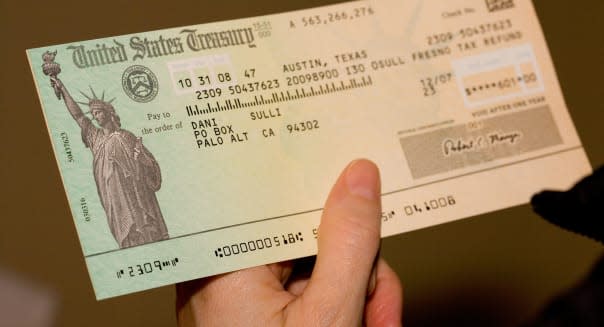Why Wait for Your Tax Refund? Get It Sooner by Cutting Out the IRS

Looking forward to filing your 2013 taxes so you can get that big, fat tax refund check you've been waiting for? You're not alone. But does the idea of that check make you quite as happy when you remember that it represents money you never really had to pay in the first place?
Unless you're getting back more than you paid in (via refundable tax credits), your refund is simply Uncle Sam paying you back money you loaned him, interest-free, by overpaying your taxes throughout the year.
It's your money -- so why not keep control of more of it? Whatever it is you're looking forward to using your annual refund check for, you could do it earlier if you weren't forcing yourself to wait for the government to process your refund first.
How to Keep Your Money In Your Wallet
You're in control of how much money you send to Uncle Sam. Your goal should be to pay what you owe when you owe it, while being sure to pay at least enough and quickly enough to be covered by one of the IRS's "safe harbor" provisions. As long as you're covered by at least one safe harbor rule, you can settle the rest of your taxes by the April 15 deadline without any additional interest or penalties.
Adjusting how much you pay in advance depends on how you pay your taxes throughout the year:
If you directly pay your taxes quarterly, you should already be using IRS Form 1040-ES to estimate and pay what you owe.
If your employer withholds taxes on your behalf, you can send your payroll department an updated form W-4.
Likewise, if a major source of your income is a pension or annuity, you can send the pension administrator an updated form W-4P to update your withholdings from the pension.
If you withdraw money from an IRA, your IRA custodian should provide you with a form to use to adjust your withholding.
The Safe Harbor Rules
As long as you pay enough through withholdings or timely estimated payments, you only need to settle the rest of your taxes due by April 15 to avoid penalties. You've paid enough if:
You owe less than $1,000 for that April 15 deadline.
You've paid at least 90 percent of your total tax due for the year (or 66.7 percent if at least two-thirds of your income comes from farming or fishing).
You've paid at least 100 percent of your total tax due for the previous year (or 110 percent of your total tax due for the previous year if your income was $150,000 or more [or $75,000 or more if married filing separately]).
If you're paying estimated taxes, those payments must be timely to avoid the penalty. To make that tax payment timely, the general rule is that you need to pay taxes based on when you earned the money. Therefore:
Money earned from January through March needs to be paid by April 15 of that same year.
Money earned from April through May needs to be paid by June 15 of that same year.
Money earned from June through August needs to be paid by Sept. 15 of that same year.
Money earned from September through December needs to be paid by Jan. 15 of the next year.
And yes, having the payment postmarked on that date counts as being timely.
It's Complicated, but Worth It
Ultimately, the money you getting back in your refund was yours to begin with, and most or all of it never should have been sent to Uncle Sam in the first place. By keeping that money in your pocket, you can better plan your day-to-day life and your savings goals around what you earn, when you earn it.
Nobody -- not even the IRS -- expects you to get your taxes right down to the penny in advance of the April 15 deadline. But by following the safe harbor rules, you can stay close enough to paid up that when you square up with the IRS every spring, you won't owe any penalties. And since that's what it takes to keep your money in your pocket, it's probably worth the effort.
Chuck Saletta is a Motley Fool contributing writer.

